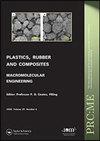Preparation and characterisation of silver nanoparticles/graphene oxide hybrid nanofiller reinforced-polyaniline
IF 1.2
4区 材料科学
Q3 MATERIALS SCIENCE, COMPOSITES
引用次数: 6
Abstract
ABSTRACT The silver nanoparticle (AgNP) coated graphene oxide (GO) hybrid nanofiller (Ag@GO) reinforced polyaniline (PANI) nanocomposite via in situ polymerisation method is synthesised. Fourier transform infrared (FTIR) spectroscopy analysis revealed the existence of chemical interactions between the Ag@GO hybrid nanofiller and the PANI matrix. The ultraviolet–visible (UV–VIS) spectroscopy showed the presence of a silver nanoparticle peak. The nanostructure morphology of scanning electron microscopy (SEM) and transmission electron microscopy (TEM) established the presence of AgNPs on the surface of the GO nanosheets that successfully reinforced into the PANI matrix. The thermogravimetric-differential scanning calorimetry (TG-DSC) thermograms revealed that the thermal stability of the PANI/Ag@GO nanocomposite was significantly enhanced due to the synergistic effect imparted by the AgNPs, GO, and PANI matrix. The dielectric relaxation spectroscopy (DRS) study indicated that the dielectric behaviour of the PANI/Ag@GO nanocomposite was enhanced because of the strong interfacial interactions existing between the Ag@GO hybrid nanofiller and PANI matrix. Polyaniline/Ag@GO nanocomposite has been prepared via in situ polymerisation method. The results showed that the thermal stability as well as the dielectric properties of the PANI/Ag@GO nanocomposite increases due to the synergistic effect imparted by the GO, AgNP, and PANI, which may be suitable for application in the energy storage devices. GRAPHICAL ABSTRACT纳米银/氧化石墨烯杂化纳米填料增强聚苯胺的制备与表征
摘要采用原位聚合法制备了纳米银颗粒(AgNP)包覆氧化石墨烯(GO)杂化纳米填料(Ag@GO)增强聚苯胺(PANI)纳米复合材料。傅里叶红外(FTIR)光谱分析表明Ag@GO杂化纳米填料与聚苯胺基体之间存在化学相互作用。紫外可见光谱(UV-VIS)显示银纳米粒子峰的存在。扫描电子显微镜(SEM)和透射电子显微镜(TEM)的纳米结构形态确定了氧化石墨烯纳米片表面存在AgNPs,并成功地增强到聚苯胺基体中。热重-差示扫描量热(TG-DSC)热图显示,由于AgNPs、GO和PANI基体的协同作用,PANI/Ag@GO纳米复合材料的热稳定性显著增强。介质弛豫光谱(DRS)研究表明,Ag@GO杂化纳米填料与聚苯胺基体之间存在强烈的界面相互作用,从而增强了聚苯胺/Ag@GO纳米复合材料的介电性能。采用原位聚合法制备了聚苯胺/Ag@GO纳米复合材料。结果表明,由于氧化石墨烯、AgNP和聚苯胺的协同作用,PANI/Ag@GO纳米复合材料的热稳定性和介电性能均有所提高,适合应用于储能器件。图形抽象
本文章由计算机程序翻译,如有差异,请以英文原文为准。
求助全文
约1分钟内获得全文
求助全文
来源期刊

Plastics, Rubber and Composites
工程技术-材料科学:复合
CiteScore
4.10
自引率
0.00%
发文量
24
审稿时长
4 months
期刊介绍:
Plastics, Rubber and Composites: Macromolecular Engineering provides an international forum for the publication of original, peer-reviewed research on the macromolecular engineering of polymeric and related materials and polymer matrix composites. Modern polymer processing is increasingly focused on macromolecular engineering: the manipulation of structure at the molecular scale to control properties and fitness for purpose of the final component. Intimately linked to this are the objectives of predicting properties in the context of an optimised design and of establishing robust processing routes and process control systems allowing the desired properties to be achieved reliably.
 求助内容:
求助内容: 应助结果提醒方式:
应助结果提醒方式:


